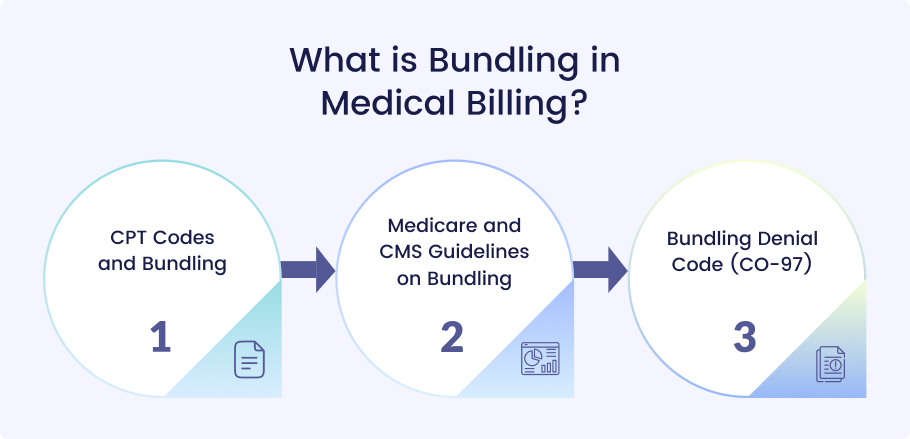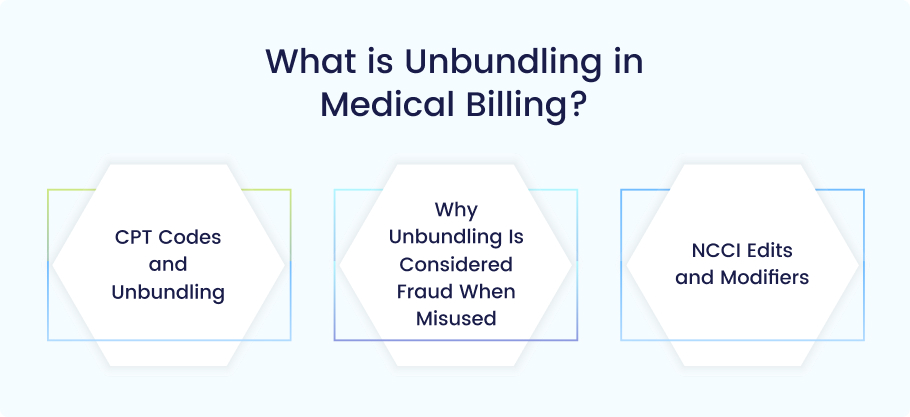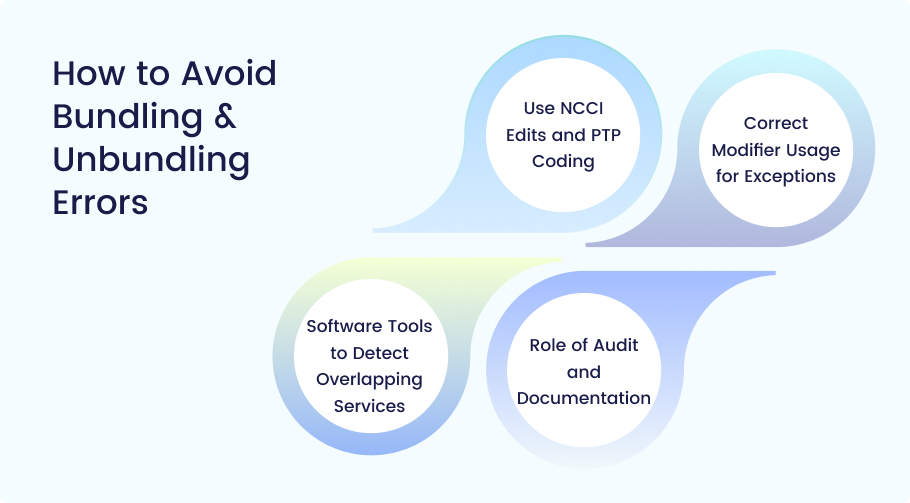Bundling and unbundling may sound like tech jargon.
But in medical billing, they can make or break your claims.
If you’ve ever dealt with denial codes like CO-97 or wrestled with CPT codes such as 99213, 90837, or 71020, you’ve likely run into these concepts already, maybe without realizing it.
This guide breaks down what bundling and unbundling mean.
Why they matter for compliance and revenue.
And, finally, we will discuss how to avoid costly mistakes using NCCI edits, using proper modifiers, and smart billing practices.
Whether you’re a provider, coder, or RCM pro, this is the clarity you need.
So, you can avoid billing repetitions, audits and no doubt, revenue loss which is the ultimate target of practice.
Let’s start with bundling in medical billing.
Bundling is the process of combining two or more related healthcare services into a single CPT code for billing purposes.
Instead of billing each component of a procedure separately, payers (like Medicare) require you to bill one code that “bundles” everything together.
You may have a question here that which services are bundled in a single code?
The answer is, those services that a provider delivers in a single episode of care.
Then, groups all and code them collectively.
While, if you don’t do so, it will take time to document and code each service one by one.
Because, billing all services separately may be confusing.
You need to assign correct codes and modifiers.,
It also aligns with the payer’s reimbursement policy. As a result, the bundling of medical services streamlines billing and reduces unnecessary costs.
In short, if services are clinically related and typically performed together, you don’t get paid for each piece—you bill the full package.
Bundling all services in a single package helps healthcare providers:
- Submit clean claims.
- Avoid CO-97 denials.
- Stay compliant with CMS, Medicare, and HIPAA coding rules.
- Reduce your audit risk from improper billing.
- Improve your RCM performance with better charge capture.
- Avoid fraud risk which, no doubt, is an upcoding or overbilling.
CPT Codes and Bundling
Providers can bundle same day visits, procedures and services using a single CPT code.
To understand CPT codes and their bundling for combining multiple procedure, see these examples:
- Suppose you perform an established patient office visit using CPT code 99213 or 99214 on the same day as psychotherapy (90837).
In many cases, these are not billable separately unless they meet a very specific criterion.
According to NCCI PTP edits, psychotherapy often includes a level of evaluation and management, so the visit (99213/99214). Hence you can bundle it into 90837.
- In another example a provider order both 71010 (chest X-ray, single view) and 71020 (two views). If he performs both on the same day, CMS may bundle the single view into the two-view code, 71020, because it already includes what’s in 71010. The provider may lose payments for both.
As a healthcare provider, keep in mind that, these pairings—what bundles and what doesn’t—are determined by NCCI edits, especially the Procedure-to-Procedure (PTP) edits.
Medicare and CMS Guidelines on Bundling
Bundling isn’t just about logic.
It’s about rules. Centers for Medicare & Medicaid Services (CMS), through the National Correct Coding Initiative (NCCI), updates bundling guidelines every quarter.
Keep in mind, the CMS NCCI edits are strict.
They define exactly which CPT codes are billable together and which combinations are wrong.
There are three main things you should check:
- PTP Edits – Do the codes conflict?
- Modifier Indicator – Can a modifier override the edit?
- Global Surgical Package Rules – Are you within a global period where related services are automatically bundled?
Some code combinations have labels like “mutually exclusive”. It means both are not billable together under any circumstances.
Others allow for an exception if the services were clearly distinct and separate.
That’s where modifiers like 59, XE, XP, XS, XU come into play.
But only if they fully support documentation.
Check Column 1/Column 2 code pairs in the NCCI edits. Column 1 is the primary code.
Column 2 is typically the one that’s bundled into Column 1.
You only bill Column 1—unless documentation and clinical necessity allow otherwise.
Remember, improper use of modifiers to bypass bundling rules is a red flag for audits.
CMS, OIG, and commercial payers may view it as unbundling fraud if you can’t back it up.
Bundling Denial Code (CO-97)
Ever seen CO-97 or PR-97 on your EOB?
That’s a bundling denial code.
These denial codes mean the payer refuses to pay for a code because it was part of another service.
- CO-97: “The benefit for this service is included in the payment for another service you’ve already billed.”
- PR-97: Same as CO-97, but patient responsibility is involved.
These denials happen when:
- You bill services that are considered inclusive.
- You forget to add a modifier when it was allowed.
- Your documentation doesn’t justify separate billing.
Each CO-97 denial represents lost revenue, increased admin work, and potential compliance issues.
Unbundling happens when a provider bills separately for services that are already included in a single comprehensive CPT code.
It’s like breaking apart a packaged deal and charging for each item individually—when the payer only allows payment for the bundle.
This can lead to higher reimbursement, but when it is incorrect, it can also trigger denials, audits, and worse—fraud investigations.
For example, if a code already includes prep, incision, closure, and dressing, and you bill for each of those steps individually, you’ve unbundled that service.
And unless there’s a very good, strong reason, you should avoid.
CPT Codes and Unbundling
Let’s say a surgeon performs a minor procedure.
The correct CPT code (e.g., 12001) includes incision and closure.
If the coder submits separate codes for:
- Incision
- Wound closure
- Dressing application
Instead of using one bundled code, that’s unbundling.
It might look like legitimate billing at a glance.
But, from a healthcare compliance perspective, it’s not.
Why?
Because the payer only reimburses for the complete procedure, not each step broken out.
Another example:
Imagine billing 90837 for 60 minutes of psychotherapy, then also billing a full E/M code like 99214 for the same session—without clear documentation of a separately identifiable service.
Unless modifier 25 is properly applied, and the note supports both services as distinct, that’s likely an unbundling error.
The CPT Manual and CMS Local Coverage Determinations (LCDs) often give clear examples of bundled services. Always check those before coding multiple services.
Why Unbundling Is Considered Fraud When Misused
Unbundling can sometimes be an honest mistake, especially when coders or providers don’t understand the NCCI edits or what’s included in a primary CPT code.
But repeated unbundling—especially for financial gain—is fraud.
Here’s why:
- CMS and the OIG view unbundling as a way to upcode and overbill.
- It violates HIPAA coding compliance and payer contracts.
- It increases the risk of civil penalties, repayment demands, or even exclusion from Medicare.
The Office of Inspector General (OIG) regularly flags improper unbundling as a major fraud concern in audits.
Providers who “unbundle” intentionally to get more money could face investigations.
If it’s not clinically justified and not properly documented—don’t split the codes.
NCCI Edits and Modifiers
There are cases where separate billing is allowed—even necessary.
That’s where the National Correct Coding Initiative (NCCI) and modifiers come in.
NCCI Edits
The Procedure-to-Procedure (PTP) Edits in NCCI show which codes:
- Must be bundled
- Can be separated using modifiers
- Can never be billed together
Each edit has a modifier indicator:
- 0 = No modifier allowed. You must bundle.
- 1 = Modifier may be used if appropriate.
Modifiers That Help Distinguish Legitimate Unbundling
When services are distinct and separate, apply these modifiers correctly:
- Modifier 59 – The most commonly used. Indicates a service that’s separate and not normally included.
- XE – Separate encounter.
- XS – Separate structure or organ.
- XU – Unusual non-overlapping use.
- XP – Separate practitioner.
But use them wisely. Don’t throw in Modifier 59 just to bypass bundling.
Claims systems and payers track overuse and misuse of modifiers.
And if you’re audited, you’ll need documentation to prove the separation.
So, keep clinical notes that clearly explain why the services were separate—timing, location, reason, medical necessity.
Without that, your modifier won’t hold up in an appeal or audit.
Understanding the difference between bundling and unbundling is essential for correct coding, faster reimbursements, and staying out of compliance trouble.
Both have their place—but only when used correctly.
Let’s break them down side by side.
Use Case Comparison
Bundling
Bundling is used when two or more services are inherently part of a single procedure. Instead of billing separately, you report one CPT code that covers it all.
Example:
- An established patient visit (99213) that includes routine blood pressure check and documentation. You don’t bill separately for the BP check—it’s part of 99213.
- If a provider performs 71010 and 71020, but they represent views of the same chest X-ray, CMS bundles them into a single line item.
Bundling improves efficiency and follows CMS and NCCI guidelines. It simplifies coding and leads to cleaner claims.
Unbundling
Unbundling is appropriate only when services are truly separate—clinically and geographically.
It involves billing multiple CPT codes that would normally be bundled, but with proper separation and modifier use.
Examples:
- A patient has a psychotherapy session (90837) in the morning and then comes back later the same day for a separate E/M visit (99214) for an unrelated issue. This can be unbundled with Modifier 25, if properly documented.
- Two distinct surgeries are performed on different anatomic sites. Use Modifier XS to indicate separate structures.
Warning: If you unbundle services that require a single CPT code, you risk denial, recoupment, or even accusations of fraud.
RCM Impact and Compliance Risk
Bundling and unbundling don’t just affect coding—they directly impact revenue cycle management (RCM), compliance, and audit exposure.
Bundling supports clean claims:
- Aligns with NCCI edits
- Fewer claim denials
- Faster payer processing
- Less rework for billing teams
- Stronger HIPAA coding compliance
Bundling done right protects your practice and ensures smoother reimbursement.
Improper Unbundling raises red flags:
- Audit triggers from payers and the OIG
- Risk of upcoding, overbilling, or unbundling fraud
- Violations of CMS, OIG, and HIPAA compliance rules
- Greater scrutiny in pre- and post-payment reviews
Even honest mistakes can lead to issues if documentation doesn’t support separate billing.
Revenue Leakage Due to Improper Coding
Improper bundling or unbundling doesn’t just cause denials—it directly drains revenue from your practice.
Underbilling from Over-Bundling:
- You might miss out on legitimate revenue by bundling services that should have been reported separately.
- If you warrant modifier, but omit, your practice loses payment.
Denials from Unjustified Unbundling:
- CO-97 or PR-97 denial codes hit when payers determine that services you billed separately should have been bundled.
- These claims either get denied outright, or worse, paid and later recouped during an audit.
Every denied or underpaid claim creates more administrative work, more time in A/R, and more effort chasing down payments.
This erodes efficiency and hurts your bottom line.
Bundling Vs Unbundling: A Comparison
| Aspect | Bundling | Unbundling |
| Purpose | Combine related services | Separate distinct services |
| Coding Method | One CPT code | Multiple CPT codes with modifiers |
| When to Use | Same site, same procedure | Different body parts, separate visits |
| Modifier Use | Rarely needed | Always needed (59, XE, XS, etc.) |
| Risk | Underbilling | Compliance audits, CO-97, PR-97 |
Pro tip for providers: Always double-check NCCI edits and modifier indicators. Review quarterly updates. When in doubt, document everything. If you’re using Modifier 59, ask yourself: Can I justify this in an audit?
Improper bundling and unbundling can lead to severe financial and legal penalties. So, as a provider, you must keep an eye to ensure things go rightly.
Here’s how you can avoid bundling and unbundling errors?
Use NCCI Edits and PTP Coding
Check NCCI procedure‑to‑procedure edits. Learn Column 1/Column 2. Consult quarterly updates. That tells you what codes bundle or must be separated.
Correct Modifier Usage for Exceptions
Use Modifier 25, 59, XE, XS, XU, XP only with clear clinical documentation. For example, modifier 25 on 99214 for a significant, separate E/M visit on same day. Modifier 91 when repeating a lab test. Always support with medical record data.
Software Tools to Detect Overlapping Services
Utilize billing software and claim scrubbing tools. They flags coding pairs that conflict with NCCI edits. Charge capture systems can recommend proper modifiers or bundling pathways. They reduce coding audits and clean claims delays.
Role of Audit and Documentation
Perform regular coding audits. Spot upcoding, unbundling fraud, or missing modifiers. Document everything clearly. Keep records to justify exceptions. In audits, that proof is your defense.
FAQs
What is the B code in medical billing?
“B codes” (status B codes) are always bundled when billed with another code in the same day of service. CMS uses them to define incidental procedures not payable separately.
How can I tell if a CPT code is bundled?
Look at NCCI edits. If it appears as Column 2 against a Column 1 code, it’s bundled unless a valid modifier applies. Software tools often flag that automatically.
What’s the role of NCCI edits in bundling?
They enforce pair logic. They define which codes are inclusive, mutually exclusive, or require modifiers. They shape clean claims and prevent improper billing.
Summing Up
Bundling and unbundling shape RCM. Proper use of CPT Codes (99213, 99214, 90837, 71010, 71020), NCCI Edits, and correct Modifiers defines coding integrity.
Avoid upcoding, unbundling fraud, and revenue leakage by staying compliant with CMS rules, OIG scrutiny, and HIPAA standards. Clean claims and accurate charge capture matter.
Strong documentation and regular audits can save you denials like CO‑97 or PR‑97.
Need help resolving bundling denials or coding audits? Contact Medheave Medical Billing Services for expert claim review and appeals.












